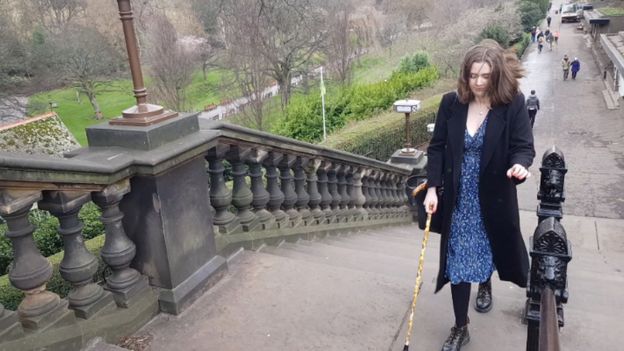“You’re too pretty to be disabled, you’re too young to be disabled, you’re too smart to be disabled” – all things Ellen Blunsdon has been told in the street.
It’s encounters like these that have made the 20-year-old Edinburgh student believe people need to rethink how they interact with disabled people.
Speaking to BBC Scotland, Ellen, who uses a walking stick, said: “I get stares and comments virtually every time I go out – people can say things that are just very inappropriate.
“I was once in a shop and a woman told me I was ‘an inspiration’ – and I was just shopping for crisps. I’m not an inspiration for getting out of the house.
“I don’t want to be pitied or patronised. I am a full person despite my disability.
“She probably thought it wasn’t harmful because it’s a nice comment, but it’s an example that many people don’t know how to interact with disabled people.”
‘Not a victim’
Based on her experiences, Ellen thinks there needs to be a “switch in mind-set” in how many interact with people with disabilities.
“I’m not special, I’m just ill – respect me for the person I am,” she said.
“I don’t want to be seen as a victim, because I’m not a victim. Disabled people are not victims, there’s nothing wrong with being disabled.”
Ellen has a form of Ehlers-Danlos Syndrome, a condition that affects connective tissue and can cause hypermobility of joints, joint pain and extreme fatigue.
Due to her condition, she uses her walking stick, something she accepts is not “normal” for someone barely out of their teens.
‘Hypervisible’
Having presented as “able-bodied”, and without a “marker” of her disability for years, Ellen noticed a shift in attitude towards her when she began using her walking stick routinely.
She believes the stick is a “visual indicator” of her disability, which has led to her becoming “hypervisible”, attracting “sheepish glances” from the public, and sometimes more.

The first time Ellen used her walking stick in public, she was verbally abused.
Remembering the day, she said: “I was already very self-conscious. I clipped past a stag do and heard one of them shout: ‘Hurry up lads! Even that disabled bitch is going faster than us’.”
Now using a stick routinely, Ellen sees it as much more than a mobility aid.
“It’s become an extension of my body. I have about six now. They all have different patterns and I love them dearly.
“It took a while to learn to love them. The first one I got was a horrible black one that the NHS provided – it felt a bit like an old man’s stick.
“Once I found more colourful sticks – they became something that I could express my identity with, rather than something that I was very shameful of.”
Looking back, Ellen now recognises her walking sticks as a “a bit of a metaphor” for her illness.
She said: “I’ve had to come to accept my illness as well as the stick.
“I was accepting that this is the new normal. That this is what’s happening to me and this is how I will potentially feel for the rest of my life.
“I had to make the best of it and carry on and the stick allows me to do that.”
Her acceptance however, has its limitations. At home in Aberdeen for Christmas, she decided to leave the sticks behind when leaving the house – not ready to introduce them to old school friends.
Ellen believes there is not enough education or understanding about disabilities and chronic illnesses – such as Ehlers-Danlos Syndrome.
“I wish people would understand that disability is a spectrum.
“For people with chronic illnesses, it can often be invisible. But that doesn’t make it any less life changing.
“I could walk outside and look completely able-bodied and no-one would ever know – but add the stick I become something different.”
Source: BBC






